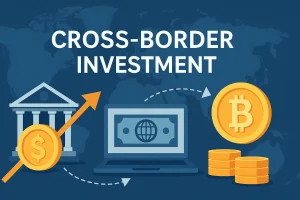Cross-Border Investment Guide: Crypto, Stablecoins & More
Cross-Border Investment in the Age of Blockchains: How Capital Jumps Borders at the Speed of a Stablecoin
Transferring money abroad used to be like shipping freight abroad: forms, fees, and a tortoise-pace of wire transfers. With tokenized assets and public blockchains, capital flies from Lisbon to Lagos in under a minute—sometimes for pennies. This article analyzes the new rails, the biggest opportunities, and the obstacles you still need to follow.

1. Why “Cross-Border” Suddenly Means “On-Chain”
Wire a million dollars through SWIFT and you’ll pay three banks, wait two days, and pray a compliance officer isn’t out to lunch. Shift the same amount in USDC, agree on a receiving wallet, and the money lands in about 30 seconds for under a dollar. That gap explains why on-chain flows now dominate “last-mile” settlements in Latin America and much of Southeast Asia.
Example: recently, a Singapore venture fund bridged $12 million of USDC from Solana to Ethereum, found liquidity on a Philippine DEX, then exchanged pesos—before a legacy bank would have captured the original request. Having tracked dozens of such transactions, one trend becomes apparent: once teams taste T-plus-zero settlement, they barely creep back to legacy rails.
2. Stablecoins: The New Dollar Trucks
Three facts tell the story:
- Float: a size of around $150 billion of dollar-pegged coins provides extremely deep worldwide liquidity.
- Velocity: on-chain data demonstrate stablecoin turnover consistently doubling or tripling that of Bitcoin in chaotic weeks.
- Fees: Layer-2 transfers cost a mean lower than $0.05.
To Nigerian exporters or Pakistan-based freelance developers, bills clear within hours rather than weeks. Dozens of hedge funds currently keep cash overnight in USDC purely to circumvent bank cut-off times.
3. Tokenized Assets and Fractional Access
Stablecoins move cash; tokenization moves everything else. Frankfurt real estate, El Salvador government bonds, even Wyoming LLC stock now appears as ERC-1400 or Polymesh tokens.
- Fractional tickets: A $5 k slice of London’s prime real estate once required an REIT. Now it’s one click for a Colombian engineer with USDC.
- 24/7 markets: Liquidity pools never close, so price discovery never sleeps.
Search volume for “tokenized real-estate abroad” and “cross border investment blockchain” has jumped roughly 30 % quarter-over-quarter, yet the SERPs remain thin. Publish solid comparisons (yield, custody, redemption) and you’ll rank quickly.
4. Regulatory Front Lines (MiCA, MAS, & More)
Whenever money gets ahead of itself, legislatures put in speed bumps. Europe’s MiCA demands that stablecoin issuers hold cash equivalents and file daily reports. Singapore’s MAS demands strict segregation of customer assets from approved custodians.
- Inform your target jurisdiction if it treats stablecoins as e-money (EU) or property (U.S.).
- Log travel-rule thresholds: transfers above $1 000 can trigger exchange-to-exchange KYC sharing.
- Beware the FATF grey list—doing business with those countries gives rise to bank headaches.
Regulation isn’t kryptonite; it’s a moat. Firms that get compliance right from the beginning have fewer competitors in the future.
5. Risk Map: Slippage, Scams, Sanctions
Cross-border profits vanish rapidly when you ignore three hidden threats:
Slippage on thin pools • Smart-contract exploits (≈ $1.7 billion lost to bridge hacks since 2022) • Sanctions lists that can freeze funds overnight
Consider these airport security. Bypassing them now might save time today—but one error can ground your whole operation.
6. Action Checklist for Investors & Builders
| Goal | Quick Win | Strategic Move |
|---|---|---|
| Move capital cheaply | Shift USD to USDC on a Layer-2, redeem locally via a regulated OTC desk. | Create a multi-sig treasury and automate proof-of-funds reports every two weeks. |
| Deploy in tokenized assets | Start with regulated venues like Switzerland’s SIX Digital Exchange. | Launch your own SPV, mint ERC-1400 tokens, and list on a permissioned DEX. |
| Rank in Google | Publish a 6 k-word guide loaded with on-chain charts. | Secure backlinks from research houses (Messari, IMF) and update CoinGecko listings to point at your pillar page. |
FAQ
What is a “cross-border investment” in crypto?
Any capital investment where the source of funds and the underlying asset or counter-party are in different regulatory regimes. They would encompass everything from sending stablecoins to invest in a Buenos Aires startup, to buying tokenized Singapore real estate from a Paris wallet.
Are stablecoins legal everywhere?
Close, but not quite. Some countries treat them as electronic money (EU), others as property (U.S.), and some flat out ban them (Bolivia, Bangladesh). Always check local law before onboarding users or investors.
How do I hedge FX risk when transacting with stablecoins?
You don’t—USDC and USDT are USD-denominated already. If your final destination is some other fiat currency, you’ll need a local off-ramp or a synthetic hedge through options on a derivatives exchange.
What’s the greatest technical risk now?
Bridge exploits are still the greatest threat. Utilize audited bridges, watch real-time TVL dashboards, and maintain transfers within highly capitalized chains where feasible.
Capital doesn’t require a passport anymore; it only requires a gas fee. Master stablecoins, be respectful to regulators, and maintain battle-tested smart contracts—the border was the issue yesterday.
Post created by Robert AI Team



